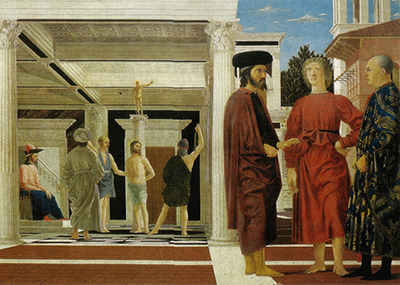The Flagellation of Christ is a painting that was done by the Italian painter Piero della Francesca between 1455 to 1460. The painting can be found in the National Gallery of the Marche (Galleria Nazionale delle Marchein Urbino), Italy.
The art features a composition that is complex and rare, and its iconography is the subject of many different theories. Flagellation made it to the best 10 paintings in the personal list created by Kenneth Clark. The theme of the art represents the Flagellation of Jesus Christ in his Passion. The composition of the painting is divided into 2 scenes, which are separated by the column supporting the temple where the Flagellation of Christ takes place. On the right-hand side, three figures are arranged in a semi-circle and the identity is not certain.
The significance of the architecture used in this painting with the stylish classical temple suggests that Piero was in touch with modern theoretical writings. The panel looks attractive as it uses a linear perspective plus the air of stillness pervading the work. For this reason, the painting was described as the Greatest Small Painting in the World by one of the prominent art historian Kenneth Clark.
The art tends to be strange since the primary subject is marginalised and the art historians have not been able to tell who is in the foreground. According to the traditional interpretation, the three young men are identified as the Oddantonio da Montefeltro, the ruler of Urbino, and surrounded by his advisors who were all killed in 1444. Another conventional opinion considers the painting a dynamic celebration initiated by Federico da Montefeltro, his half-brother and Oddantonio's successor. The interpretation is supported by an inventory from the eighteenth century in the Urbino Cathedral, where the art was kept. Nevertheless, because Guidobaldo was born in 1472, the interpretation is enormous.
Marilyn Lavin, an art historian, provided another remarkable interpretation of the art. She proposed that the two men in the painting are Ludovico Gonzaga and a colleague who had lost their sons, which is signified by the young man in the centre. In this case, the art compares the pain that the two friends felt to that of Jesus during his passion. Another interpretation suggests that the art is a symbol for the grief of Constantinople after its fall to the Muslims. In this interpretation, the two men in front of the flagellation are Murad II, the Islamic sultan and Byzantine Emperor John VIII Palaiologos. Note that there is not a definitive explanation of the painting because it has some ambiguity that gives several entry points to the viewer.




